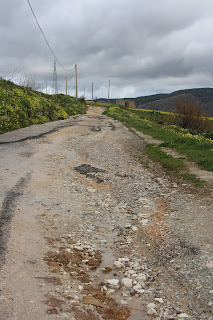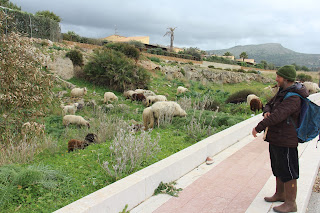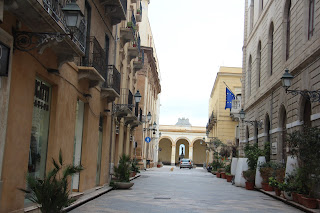We left our lovely abode in Calatafimi and headed directly for Segesta Archeological Park, which we had tried to enter after we unpacked yesterday, but, with the weather still being so variable and very few folk about, the site had been closed two hours early. So, back we came today, to see the ruins surrounded by a carpet of yellow, white, purple and orange wildflowers: some so thick, tall and glorious that they touch the olive tree branches. I had never seen such prolific wildflowers.
The rural scenery here is simply gorgeous. Small individual mountains rise sharply out of the ground, fall away into deep low valleys, some cut with little gorges that have streams running through: all green and thick with patches of thriving wildflowers, and garrigue filled with great fronds of fresh wild fennel.
We found our way easily to the front gates, but were then shooed away and sent miles downhill, where we had to leave our car in a parcheggio and pay €5 for the pleasure of a bus ride back up to where we had earlier driven. Then pay again, at another ticket seller's box, to enter. But, at least the site was open. We are finding the Sicilians are fairly flexible with their tourist venue openings and closings: it is all quite arbitrary, seemingly. There still followed a good hike uphill to the site.
Here, on these hills lived the Elymians: an ancient race of people who likely first came across the waters from Troy and happily mixed with the native folk, but regularly fought with other Greek colonists, from different parts, who were aggressively building a power base in settlements further south, around Selinunte. So much so, that after throwing their political dice behind one supporter, and losing in the toss, they attempted a power alliance with Athens as protection against the prowling Selinunte. But Athens needed to check out their credentials first--and this was around 430BC, so times have not changed so much on the political landscape since then. The Athenians informed the Elymians they would be sending diplomatic envoys to discuss an alliance. Essentially, they wanted to check out the state of Elymian affairs and finances, to see if they were worth supporting.
To impress the diplomatic visitors the Elymians built this exquisite temple on a pretty hill in Segesta. They kept it simple and super-stylish: low-set, Doric columns, simple stone gables. Basically, because they had little in their coffers. It was simply an appetiser. But, it suitably impressed the diplomats when they saw the work in progress, but the instant they left Sicilian soil and headed back to Greece worked stopped on the temple and the roof was never built, the building never finished.
All a political ploy.
Regardless, the ruin of the unfinished work is simply gorgeous, and, though well over 2000 years old, it is still in remarkable condition. We had hours here, enjoying walking where the Elymians walked.
From here, we were to go on to Erice for the rest of the day, but that road was long. First the Sat Nav chose to take us a short cut across the mountains but the road was so decayed it began to scrape the bottom of the vehicle, so after a few rough kilometres we turned back, taking a quick shot of a very grand abode set amongst the hills and the rough track as we did so. Every day the owner must drive these roads, yet he has ensured his privacy by not demanding they be repaired. Mafia, mayhap.
Low cloud over the mountain village of Erice had us quickly changing our plans. Instead we headed for the Custonaci Caves further north along the coast, hoping the clouds might shift while we spent time there.
A shepherd herding his sheep charmed us enroute to the caves. He 'chatted' away with a big smile as we took our photo. He is so happy caring for his sheep and makes the best cheese, he says. We think. Though not a word did we know, just the sense of what he was saying.
We'd packed lunch fixings, and, as we did yesterday, found a viewing spot and a wall seat in lieu of a picnic table-- this time beside the sea with a fabulous view, and ate like kings on Italian deli specialities. Our lunches are truly mouth-watering, and, at the moment, portable, as we have yet to settle in to the Sicilian ballet of learning when lunch places are open and ready, or when they are not.
A lone man pulled up while we were eating. We later saw him walking the entire area, so he was not a local, but a visitor, enjoying the scenery. His first stop, though, after parking and wishing us well in gestures we understood, was to walk to the tiny altar built in a blue and white grotto on the seafront and spend about ten minutes there chatting with the Virgin Mary. Such amazing faith these folk.
After lunch we followed little car tracks back on potholed roads into mountains that were rising sharply out of the sea and punching their ragged way inland, pocked with natural caves, the Custonaci Caves, that have been home to man since paleolithic times. Here, archeologists have found fossils dating back to those times, and, an entire cave is still there, where a local family lived from 1819 until well into the 20th century. This is famous, and called Grotta Mangiopane, named after them. Today we could only view their settlement from the road, but we could see wee caverns that they had concocted for themselves built tight against the cave walls.
Erice, on our return, was still in clouds, so that is for another day. We headed instead to Trapani and walked the town during siesta, with Miss Bec on the prowl for a post-prandial coffee. Downtown Trapani is more elegant and gracious than anywhere we have seen so far, though we had not anticipated that in planning.
Again, churches are the big beautiful feature in town: there seems to be one in every block. Today, all are closed until in dribs and drabs about three o'clock some started to reopen. There is an historic gate still standing: one of the initial four entrances to the centro storico, this one wearing a great astronomical clock on its face. The Cathedral takes pride of place in the heart of town. And the shop signs are unique and beautiful.
We found a delicious coffee for Miss Bec, then, but as the afternoon began cooling off and closing in we headed about 10 miles south to our home for the next two nights: a small farm complex run by a man and his wife that used to be his parent's farm. It grows olives, garlic, mandarins and small hard oranges that taste of vanilla. So very delicious. We were given a handful for dolce.
Our dwelling for tonight is a single-storied cottage of solid stone that could withstand a hurricane. The wardrobe is vast: all our clothes disappear into just one low set drawer. And the hangers, like curved crucifixes on hooks, look individually crafted, and unusual.
We settled in after packing with an aperitif of wine, cheese and bits of fruit from the garden, while I concocted a gnocchi dish with speck, gorgonzola and pear for our mains. This took all of ten minutes and was scrumptious, a replica of a fine dining lunch dish I had tried in Cefalù, now clipped firmly into my quick recipe repertoire.
We slept under big fat doonahs in quiet dark rooms--like logs: hoping tomorrow might bring clear skies over Erice.
 |
| Segesta built to impress and beguile a loan from their rich Greek neighbours |
 |
| Wildflowers amid the macchiato herbs |
 |
| Just us and the Elymian ghosts |
 |
| Simple lines yet super stylish, even unfinished |
 |
| Where the Elymians lived |
 |
| One of the decayed shortcuts we eventually abandoned |
 |
| A Sicilian millionaire's privacy is assured as the road to and fro is virtually unnavigable |
 |
| Best sheep, best cheese, mimed the Shepherd |
 |
| Our lunch time view on the coast |
 |
| A worker spent a good 10 minutes chatting to the Virgin Mary in her grotto |
 |
| Grotta Mangiapane, cave dwellings with fossils dating back to Paleolithic times |
 |
| Elegant passeggiata through downtown Trapani |
 |
| All quiet in Trapani until siesta is finished |
 |
| The Basilica of St Lawrence the Martyr takes pride of place in Trapani |
 |
| Astronomical clock on the face of historic Trapani city gate |
 |
| Lovely Library sign atop one of the buildings |
 |
| Delicious coffee and wine bar for afternoon tea |
 |
| Our dwelling for tonight, owners grow olives, garlic, mandarines and sweet oranges |
 |
| Our cavernous wardrobe where our clothes hangers look like curved crucifixes hooked over a rail |
No comments:
Post a Comment